Environmental Pollution ( IF 7.6 ) Pub Date : 2022-06-21 , DOI: 10.1016/j.envpol.2022.119622 Yining Wu 1 , Bowei Jiang 2 , Yu Zou 3 , Haiyan Dong 2 , He Wang 2 , Hongfei Zou 2

|
Polycyclic aromatic hydrocarbons (PAHs) are prevalent organic pollutants in coastal ecosystems, particularly in mangrove wetlands. However, it is still largely unclear how PAHs affect the soil bacterial community under various vegetation types in the Greater Bay Area. Here, we selected soil samples from four sites with different vegetation types (native mangrove forest dominated by Kandelia candel, invasive mangrove forest dominated by Sonneratia apetala, unvegetated mudflat, and riverine runoff outlet) in the Qi'ao and Futian Nature Reserves. We investigated the effects of PAHs on soil bacterial community composition and diversity, function, and co-occurrence via 16S rRNA high-throughput sequencing. PAHs obviously reduced soil bacterial community diversity and richness. Based on PICRUSt 2, PAHs demonstrated positive influences on PAHs degradation metabolism related bacterial genes. Meanwhile, we predicted that riverine runoff outlets can potentially degrade PAHs, may donate to sustain healthy mangrove ecosystem. Also, PAHs and total nitrogen (TN) were crucial factors driving the soil bacterial community in Qi'ao sites, whereas in the Futian sites, PAHs and SOC were more important. PAHs, SOC and TN showed negative effects on specific bacteria abundance. Subsequently, environmental factors and PAHs levels influenced the soil bacterial ecological functions community. Co-occurrence network analysis revealed non-random assembly patterns of the bacterial communities. SBR1031 and A4b were the keystone genera and played a crucial role whgich played an irreplaceable role in PAHs degradation in Qi'ao and Futian sites. PAHs inhibited specific microbial activity and metabolism in native mangrove forest, while affects positively to bacterial community in riverine runoff outlet which might profoundly affect the whole soil quality under various vegetation types. Overall, this study might identify existing health problems and provide insights for enhancing protection and utilization management for mangrove ecosystem in the Greater Bay Area.
中文翻译:

红树林湿地不同植被类型下细菌群落多样性、功能和土壤因子对多环芳烃的影响
多环芳烃 (PAHs) 是沿海生态系统中普遍存在的有机污染物,尤其是在红树林湿地中。然而,目前尚不清楚 PAHs 如何影响大湾区不同植被类型下的土壤细菌群落。在这里,我们从四个具有不同植被类型的地点(以Kandelia candel为主的原生红树林,以Sonneratia apetala为主的入侵红树林)选择土壤样本、无植被的泥滩和河流径流出口)在祁澳和福田自然保护区。我们通过 16S rRNA 高通量测序研究了 PAHs 对土壤细菌群落组成和多样性、功能和共现的影响。PAHs 明显降低了土壤细菌群落的多样性和丰富度。基于PICRUSt 2,PAHs表现出对PAHs降解代谢相关细菌基因的积极影响。同时,我们预测河流径流出口可能会降解 PAHs,可能有助于维持健康的红树林生态系统。此外,PAHs 和总氮 (TN) 是驱动祁澳遗址土壤细菌群落的关键因素,而在福田遗址,PAHs 和 SOC 更为重要。PAHs、SOC 和 TN 对特定细菌丰度有负面影响。随后,环境因素和PAHs水平影响土壤细菌生态功能群落。共现网络分析揭示了细菌群落的非随机组装模式。SBR1031和A4b是基石属,在祁澳和福田遗址多环芳烃降解过程中发挥了不可替代的作用。PAHs抑制原生红树林的特定微生物活性和代谢,同时对河流径流出口的细菌群落产生积极影响,可能深刻影响各种植被类型下的整体土壤质量。总体而言,这项研究可能会发现现有的健康问题,并为加强大湾区红树林生态系统的保护和利用管理提供见解。











































 京公网安备 11010802027423号
京公网安备 11010802027423号